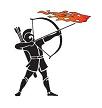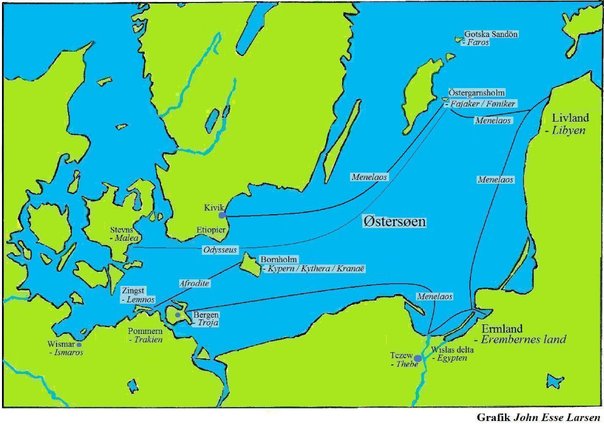
Odysseus
Isse from the island Od in Denmark
Menelaos´ tour round the Baltic Sea
A storm from the West drives Odysseus shipwrecked from Troy – that is the town of Bergen on the island of Rügen – to the Phaeakian Castle on Östergarnsholm just east of Gotland (Od.5-35,288).
The same storm hits Menelaos:
– The wind then drove our five dark-nosed ships over the waves and carried them to Egypt (Od.3-299).
They are cast from Troy on Rügen to the delta of River Wisla.
A strong wind from the South sends Menelaos to Libya (Livland) and later to the West to the island of Faros – that is the island of Fårö called Farø in the 14th century (Od.4-81,354).
Menelaos tells Odysseus's son Telemakos:
– We’d endured so much while we were wandering.
– We made it home – it took us more than seven years.
– To Kypern, Egypt, and Phoenicia.
– We even reached the Ethiopians, Sidonians, and Erembi
– Libya too, where lambs are born with horns
– and ewes give birth three times in one full year (Od.4-81).
Here Menelaos talks about six places in the southern Baltic Sea:
Kypern – it's Bornholm
Phoenicia – it's Östergarnsholm and Grogarn hilltop on Gotland
Egypt – it is the river Wislas’ delta
Ethiopians – they live in Österlen around Kivik and the Kivik Tomb
Sidonians – they are Phoenicians
Erembi – they live in Ermland just north of the Wisla delta
Libya – it is the borderland between Estonia and Latvia
Odysseus and Menelaos in the Baltic Sea

Kypern ~ Kythera ~ Kranaë – Bornholm and Kyholm
The Danish double name for Bornholm is the rock island Bornholm. The logical similarity is then:
– that Kypern (Cyprus) and the island of Bornholm is the same name and
– that Kythera and Rock Island is the same name.
– that pern and born has the same meaning in two different languages.
– that ky has the meaning holm and ø (Islet in all Nordic languages) in two different languages.
The rocky island of Bornholm is mentioned in the Iliad.
Paris from Troy says to the divinely beautiful Helen:
– not even when I first took you away from lovely Lacedaemon,
– or when I lay with you in our lover’s bed on the isle of Cranae (Il.3-444).
Paris is sailing from Sparta in Lacedaemon past Kranaë to Troy. Sparta is located in Northern Seeland at the town of Lynge. Kranaë (Greek rock island) is the island of Kythera – rock island Bornholm.
We can wonder whether the word krana has the same root as the nature stone granite.
Granite and kranit!
Could it be that Greek Kranaë (Greek Κραναῇ) is equivalent to granitø – granite island.
Mediterranean ~ Baltic Sea | Translation |
Ky – pern ~ Born – holm | pern ~ born |
Ky – thera ~ rock – ø | thera ~ rock ky ~ holm / ø |
Kranaë ~ rock – ø (isle) | krana ~ rock ë ~ ø / øy |
The sure thing here is – that ky means holm or ø (English island).
There are three Danish islets named Kyholm and all three are close to Odysseus’ home on the island Od, and Od is pronounced exactly as the Norwegian word øy, which means island.
There is even a Danish island with all three words, namely: Kyø Holm in Nibe Bredning in the Limfjorden.
Kyholm in Stavns Fjord on Samsø (Samos), opposite Odysseus on his home-island Od
Kyholm in Egense Dyb in Odense Fjord, opposite Odysseus on his home-island Od
Kyholm at the island Enø in Dybsø Fjord just south of the island Od
Just north of Bornholm – or Kypern – in the Baltic Sea lies the town Kivik with the Kivik Tomb from the Bronze Age.
Kivik is called Kÿwig in 1532 and Kiwig in 1611, 1615 and 1617. The suffix – vik means intake or cove. At Kivik there are three intakes and therefore two islets. Or in the language of the Odyssey – two ky.
There has been a quarantine station on Kyholm in Stavns Fjord during the plague of 1709 – 1711 and during the cholera epidemic of 1831 – 1857. During the Napoleonic wars from 1801 to 1815 Kyholm was a naval base.
After 1857 the buildings were demolished and the island is now uninhabited.
The Erembi in Ermland
The Erembi means the amber people, Latin ambar – English amber.
Menelaos tells Odysseus's son Telemakos:
– We’d endured so much while we were wandering.
– We made it home – it took us more than seven years.
– To Kypern, Egypt, and Phoenicia.
– We even reached the Ethiopians, Sidonians, and Erembi
– Libya too, where lambs are born with horns
– and ewes give birth three times in one full year (Od.4-81).
He came first to the Ethiopians. It is a people with two tribes in Scania.
Then he came to the Sidonians. That is the Phaeakians on Gotland.
The third people he visits is the Erembi who apparently live in Egypt, the delta of the river Wisla.
This corresponds with our historical knowledge. The Erembi live in the province of Ermland, which lies just north of the Wisla delta in the former East Prussia. Ermland and the Samland peninsula are also known as the amber coast.
Ermland is called Wârmê in Prussian, Samland is called Sembâ and the true name of Prussia is Prûsâ.
The name Erembi means almost certain the amber people from an old *erembh – that becomes Indo-European *erebh-, common Germanic *raba and Nordic rav, Latin ambar and English amber.
This is an example of a double assimilation that ends with a bilabial assimilation. There are many examples of that, and here are three words – dumb, lamb and amber.
The common Nordic word dum. Indo – European *dhumbh-, common Germanic *dumba – Old Norse dumbr and English dumb.
The common Nordic word lam. Indo-European *lonbhos, common Germanic *lambaz – Old Norse lamb and English lamb.